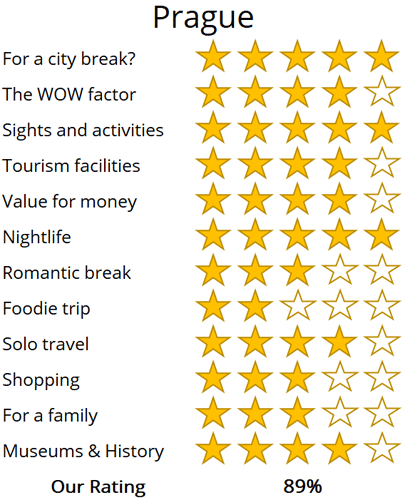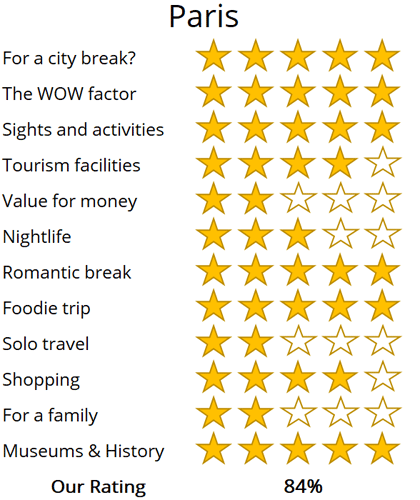WhereToGoForMyHoliday.com
The best destination comparison site!
WhereToGoForMyHoliday.com
The best destination comparison site!
Prague or Paris a vs city comparison and travel guide
Prague and Paris both offer unique and enticing experiences, but which one should you choose for your city break or holiday?
We understand your dilemma. There is an abundance of travel guides for both cities, but few actually comparing them, and advising you which is the better for your trip.
This article will provide our unbiased and independent views of Paris and Prague, hopefully making your choice that little easier.
The article is structured into several sections, each of which can be directly accessed through the following links:
• Introduction to the cities
• Scores and ratings
• Which one should I, friends, or family visit?
• When to visit and weather
• Who is the city suited for?
• The perfect 48hours (with map)
• Tourism details (where to stay? airport details?)
Introduction to Prague and Paris
Prague, the Czech capital wows visitors with its Gothic castles, cobbled lanes and handsome medieval plazas.It sits on a snaking bend in the Vltava River, unfolding with a fairy-tale Old Town district that flits from curious astronomical clocks to age-old synagogues at just the turn of a corner.
Around that are other neighborhoods that beat with hipster cafes or come topped with the stunning spires of Prague Castle – one of the largest medieval fortifications in the world.
You can fill days glugging frothy beers in cosy basement bars. You can trace the footsteps of Franz Kafka in award-winning literature museums. You can delve into enchanting Christmas Markets or gaze at great monuments on Wenceslas Square.
What's more, Prague sits smack bang in the heart of the beautiful region of Bohemia, a land of undulating hills and beer breweries that offers a taste of rural Europe.
Paris is famed as the capital of Romance, the epicentre of French culture and grand European art, and the home of iconic monuments like the Eiffel Tower. There's no question that it's an amazing city to explore.
Everywhere you go along the Seine River it seems like there's a world-class museum or gallery beckoning. But Paris can also be overwhelming, not to mention downright gritty in some parts.
The history here goes back to the Celtic tribes of the 400s BC. But it was the 7th-century fortifications on the Île de la Cité that went on to form the medieval kernel of the town.
The capital still radiates out from that, with bohemian neighborhoods along the Canal Saint-Martin, stereotypically Parisian cafes and cobbled streets in Montmartre, and enthralling cultural and foodie attractions throughout other arrondissements (areas).
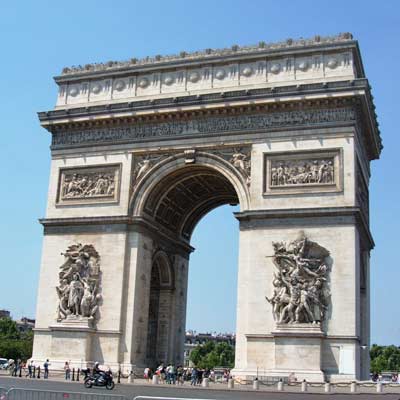
The Arc de Triomphe, constructed as a memorial to the soldiers who perished in the Napoleonic Wars and French Revolution

The main square in Prague with the Tyn Cathedral
Prague vs Paris: City Ratings
Summary
Where would I journey for a personal escape?
Prague
Where would I send my parents for a memorable visit?
Prague
Where's the ideal destination for my adventurous 19-year-old cousin?
Prague
Where should my food-obsessed friend indulge their culinary passions?
Prague
Note: The above comparisons are weather-independent and are based on travel during the most opportune times of the year. Details about the ideal travel seasons are elaborated upon later in this article.
In the sections that follow, you'll find a comprehensive comparison between these two fascinating cities. This includes recommendations on the duration of stay, the best times to visit, and tailored 48-hour itineraries for each city.
The final segment delves into practicalities for your travels, such as the best airport to fly into, the optimal districts for your accommodation, and insider tips, for when you come to explore the city.
We hope that you find all of this information useful, in planning your next exciting trip!
Destination details
How long to spend each city?
Paris could take a lifetime to explore completely. This is a living, breathing, sprawling capital city, which means even the locals can be surprised at the new cafes, bistros, and cultural events that come and go. For travellers, at least three days is a good idea.
That's probably just enough to see the mainstay sights and hop into the Louvre to catch a glimpse of the Mona Lisa. Trips to explore outer arrondissements and sample Paris's pumping nightlife should probably be between four days and a whole week, with more extensions needed if you want to hit the Loire Valley for wine tasting.
Prague is one of the original European city break destinations. With countless low-cost carriers whizzing in and out, it should be easy to put together a short trip here on a budget. To unearth the secrets of the Old Town, see Prague Castle, and enjoy at least a night on the beer and the goulash, a few days is probably all you'll need.
Of course, if you've got extra days, Prague will surely fill them. Excursions out to the wooded valleys of Bohemia, where the castles of Český Krumlov and Kutna Hora await, can be added into the mix. But you could also stay in the city itself, to break away from the more touristy centre into neighborhoods like hipster Žižkov and Nusle.
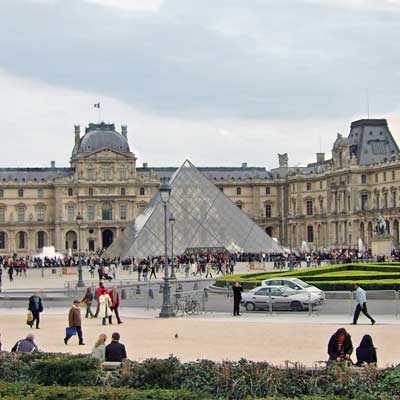
The Louvre with its distractive glass pyramid

The delightful Prague Orloj is the world’s oldest operating astronomical clock, and displays the position of the Sun and Moon
Prague has the usual four seasons of Central Europe. The summer is generally hot and humid, with the highest temperatures in the 30s during July and August. It's also common to have regular thunderstorms that last for short bursts then. Winter, meanwhile, is cold. It's the best time to visit Prague if you're in search of kitschy Christmas markets that sell blood sausages, hot chocolate and warm Czech beer. You'll certainly need the thermals and snow coat between November and March, though. It's not uncommon for temperatures to stay below zero for weeks on end.
The upshot is that the spring and autumn probably see Prague in its prime. In April, May, September and October, things can still be mild and warm. There are fewer visitors hitting the mainstay sites like the Prague Castle. Hotel rates drop considerably to boot, and you're more likely to get bargains on flights into town.
Paris is known for its café culture, it would be a shame to miss all those al fresco coffees on the canal side. Enjoyments like that are most likely to be had in the warmer months, which – this far north in France – means May to September.
Outside of those, the rainfall picks up and things get chilly. That said, the summer is the most expensive and busy part of the year, so you'll be contending with others for those selfies by the Eiffel Tower.
Visits pre-Christmas tend to be pricier than those after Christmas. If you're eager to cosy up and see Paris in the ice and cold, you might want to push your break to February or March. Those months tend to be nice, quiet and free from the tourist masses.
Paris is a master of art and culture. From the gold-gilded palaces of Versailles to the endless works of the Louvre and the Musée d'Orsay, you'll never be short on paintings or architecture or sculpture.
But the best Paris trips mix all that with a little bit of food, some classic sightseeing, and even a touch of hedonism. That makes this a versatile city-break option, offering wine bars and bucket-list attractions like the Eiffel Tower.
It's probably worth dodging Paris if you're not the sort who deals well with crowds, traffic, and big cities. The nearest place you can go to escape to nature are the forest parks on the outskirts. What's more, it can take a while to get from A to B in the French capital.
Prague is a heritage-rich, historic and hedonistic European city. You'll spend your time gawping at haunting castles and getting lost in medieval districts. Of course, there's also plenty of room for evenings of Czech beer and samplings of Slavic dumplings and goulash. If you're a food-loving culture vulture then there's hardly anywhere better on offer. What's more, backpackers and partygoers will find loads to like in the sleepless basement bars and pubs.
What Prague can't excel in is proximity to the ocean. If you're looking for somewhere to dine on seafood and hit the beach, it's not the place for you. The same goes for the great outdoors. It isn't hard to escape to backcountry Bohemia from here, but you will need to rent a car or organise a day trip away from the Old Town to do that.

The Charles Bridge spans the Vltava River in central Prague and is lined the thirty Baroque statues
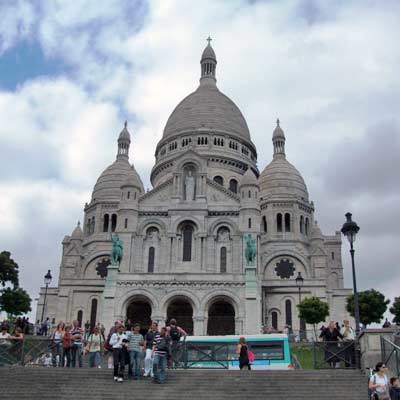
The Sacré-Cœur provides one of the finest view of Paris
Paris in 48 hours is a hard ask, but this itinerary should help distil the city's preeminent culture, art and atmosphere into two short days:
Day 1: Breakfast time in the 19th arrondissement. Local and traveller joints meet there, with some charming cafés and bakeries lining Le Bassin de la Villette, where there are open-air swimming spots in the summer months. Then, move south-west along the picturesque Canal Saint-Martin.
It takes you to the beating heart of the city, just shy of where the Île de la Cité hosts the beautiful Cathedral of Notre Dame. Take your photos and then move across the Seine River to the famous Latin Quarter.
It's the perfect place to explore in the afternoon, with boutique bookshops and atmospheric cafés aplenty. For the afternoon, cross the water again and duck into the Louvre Museum.
The morning rush should have subsided, so you can wander the exhibition rooms in search of the Mona Lisa and the Venus de Milo without having to jostle with too many. In the evening, return westwards to hipster Belleville. This district is one of Paris's Chinatowns, with more noodle shops and dim sum outlets than you can shake your guidebook at.
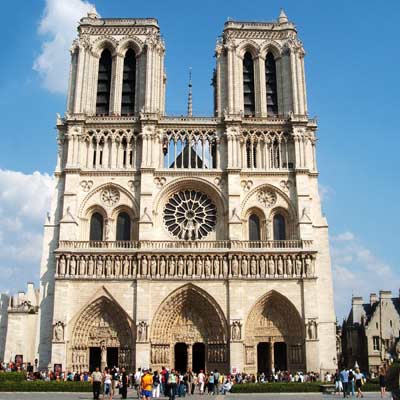
Notre-Dame
Day 2: Seek out the bohemian neighborhood of Montmartre to start your second day in Paris. It's known for its zigzagging cobbled streets and urban staircases, but also comes replete with cosy coffee houses with crispy croissants. At the very top of the hill where the district is draped is the gorgeous Sacré-Cœur. Its great travertine domes gaze over the city, so expect some awesome views.
On the way down, heading west, you might just pass by the infamous Moulin Rouge and its makeshift windmill all lit up in red neon. You can catch a metro from that to go along to Ternes. Emerge and you'll be looking straight down at the Arc de Triomphe, which marks the start of the Champs-Élysées – a place to shop till you drop.
Be sure to pull yourself from that grand boulevard with enough time (and light) left to see the Eiffel Tower in all its glory. The landmark is just over the river to the south, but the best view might be from the Trocadéro Gardens on the northern banks.
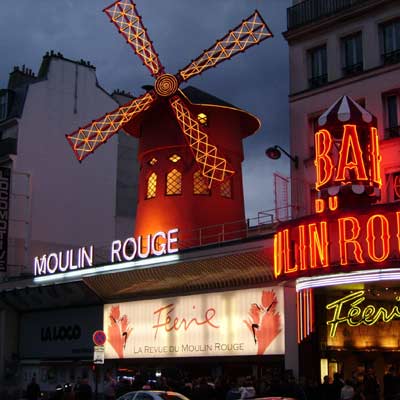
The Moulin Rouge
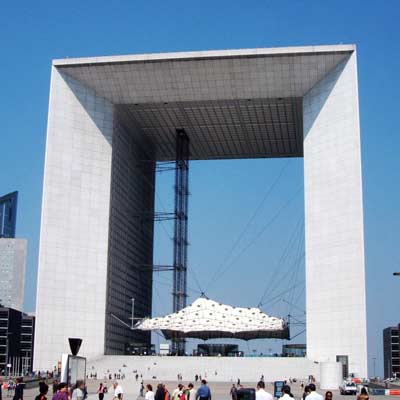
La Défense is the modern side to grand Paris
48hours in Prague
Spending two days in Prague allows for a perfect balance between exploring its historical wonders and delving into its vibrant urban life. The enchanting Old Town and the imposing Prague Castle splendidly represent the city's rich history, while trendy districts such as Žižkov offer opportunities to enjoy coffee and scour through the markets.
Day 1: Start your weekend right in the heart of the city at the expansive Old Town Square, the central hub of Prague's historic quarter. It remains lively throughout the year, bustling with visitors meandering between significant landmarks such as the Old Town Hall and the Church of Our Lady before Týn. Notably, the church is renowned for its striking black Gothic turrets, towering over 80 metres tall.
Meanwhile, the Old Town Hall boasts stunning Gothic doors and gargoyles, and is home to the unique Prague Astronomical Clock. This 15th-century timepiece is the oldest functioning astronomical clock worldwide, drawing crowds every hour to witness its charming chime and the procession of apostles.
Continue east through the Old Town's intricate alleyways until you reach the riverside, leading directly to the iconic Charles Bridge. Adorned with statues of saints, it offers picturesque scenes, especially in the misty winter mornings. Cross over to Malá Strana, Prague’s oldest district, filled with traditional beer taverns such as the popular U Hrocha.
After a refreshing beer, it's time to ascend to Prague Castle, conveniently located steps away from the tavern. Dedicate your afternoon to exploring this vast complex, ranging from the magnificent St. Vitus Cathedral to the quaint workshops of Golden Lane.

The Dancing House may be one of Prague’s most distinctive buildings, but being in the heart of the old town its unique design was extremely controversial
Day 2: Treat yourself to a hearty breakfast in boho Žižkavárna Café. It's loved by the locals for its strong coffees and homemade cakes but is also a fantastic intro to the stylish neighborhood of Žižkov itself. The landmark at the heart of that district of the soaring Žižkov Television Tower in Tower Park Praha. Be sure to take in its futuristic architecture from below before going inside. Then, it's straight up to the observation decks to enjoy sweeping views of the city.
You'll also want to drop by the National Memorial on Vítkov Hill. It's an important spot in the annals of Czech history. It was once a hops plantation but now hosts the colossal equestrian statue of Jan Žižka (a revered Czech military general) and the Tomb of the Unknown Soldier, a symbolic monument to resistance to Nazi occupation.
Keep going north across the river to Prague 7 and you'll find stripped-down hipster cafés like Kavárna Liberál. For dinner, try the multi-ethnic stalls of Hala 22 closer to the waterside, where everything from Rajasthani curry houses to Chinese noodles are options. Finally, get your beer drinking hat on, because Gyllene tigern – a legendary microbrewery – beckons with its hoppy unpasteurized tipples back in the Old Town.

The Klaus synagogue and cemetery, in the Jewish quarter of Prague
The Václav Havel Airport Prague is the main entry point to the Czech capital. It's also the largest international airport in the Czech Republic. That means short-haul flight connections arrive there from all over, and you can usually bag some wallet-friendly bargains on carriers like Ryanair and EasyJet
For a European capital, Prague is very walkable and bikeable. The whole Old Town is actually best explored on foot, and the same goes for the castle district. For longer trips, the uber-efficient Prague Metro and tram network combine on the PID ticket to offer easy hops from A to B.
The basic ticket costs 24 CZK ($1) and allows access and transfers for 30 minutes. Buy them via the Prague transport mobile app, in local newsagents, or at the tram stops themselves. Don't forget to validate your ticket at the yellow machines on board.

The Gothic Saint Vitus Cathedral lies within the Prague castle complex
All the usual crimes and scams of a European capital are present in Prague, though the town is generally very safe for visitors. Be vigilant of pick pocketers in busy areas and on public transport especially. Also try to dodge picking up taxis straight off the street – tourists are often prime targets for inflated rates. Prague's currency exchange points are notorious for being rip offs, so get your koruna before touching down.
For proximity to the main sites and bars, there's really nowhere better to bed down than in the Prague Old Town. Hotels will usually cost the most there, however. Something quieter and equally as atmospheric is available in the Malá Strana. But the New Town district and Žižkov are also both good options.
Paris is served by two large international airports. Low-cost carriers typically use Orly. From there, you can hop to Anthony Train Station and then switch to the urban metro line to reach the city. The trip costs around €12 in total. The more famous and larger airport at Roissy Charles de Gaulle is for long-haul fliers and premium services. It's linked straight to the Gare du Nord station in the middle of the city by regular trains that take around 35 minutes from terminal to town.
Choosing the right area to stay in Paris is important because each arrondissement has its own distinct vibe. You can pay extra and be somewhere like Grenelle and the 7th, where you're most likely to open your hotel window and be gazing at the Eiffel Tower. Or, you can opt for a B&B somewhere like the Canal-Saint Martin – a vibrant, student favourite – or in the 11th arrondissement – cheaper and more lived-in.
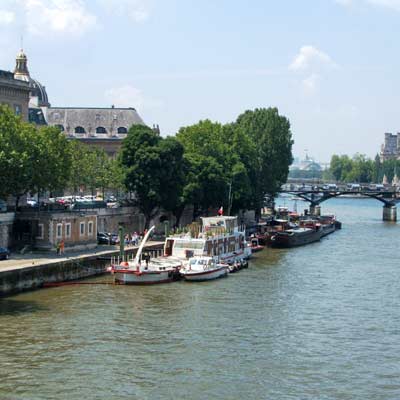
The Seine River meanders through the centre of Paris
The Parisian transport network is vast and efficient. Travelers shouldn't need more than the RER and Metro combination. They can be caught to virtually all the major sights and areas around the capital. You can purchase a contactless card ticket to travel on all the lines – tariffs are €1.90 per ride.
Even among the French themselves, the Parisian people are renowned for being curt and a little rude. Remember that this is a working, living metropolis, so expect central areas to be busy with commuters and the like. You'll also want to be especially cautious on public transport when carrying large luggage or travelling at night, because pickpocketing and thefts certainly aren't unheard of.

oh we were stuck in the airport!

Copenhagen was a bit expensive...

All we did was drink beer in Brussels...

Muncih was crazy

And we got so burnt!

Remeber that night in Rome

oh we were stuck in the airport

So much fun kayaking

Berlin and that group from Austria!

There was such a view from that church

And we got so burnt!

Munich was eventful, wasn't it!

Such a view from that cathedral in Florence

Lisbon was such so much fun

Last summer was so much fun .... x

Remeber that night in Rome

Lisbon was such so much fun

Such a view from that cathedral in Florence

Munich was eventful, wasn't it!

And we got so burnt!

Remeber that night in Rome

All we did was drink beer in Brussels...

Berlin and that group from Austria!

Can't wait to go back to Dubrovnik

Remember that boat ride in Prague

Copenhagen was a bit expensive...
